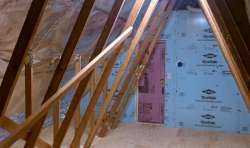BASEMENT, ATTIC, GARAGE REMODELING
According to the data in the latest home improvement cost vs. value report for our region, which includes Chapel Hill, Durham and Hillsborough, expanding the living space by means of attic or basement remodeling offers the highest recouped cost level of any possible project. Reclaiming some of the room your house already has does not involve increasing it's footprint, with all the involved digging, foundation and ground-up building. This makes such a project significantly more cost-efficient than other ways of adding some living space. Unfinished attics and basements can hold great potential in accommodating a play room, exercise or entertainment space, guest room or in-law suite.
Attic insulation
Ceilings that serve as barriers between attic and the living space are known to be the greatest sources of heat loss in the winter and heat gain in the summer because of the great temperature differences, which occur in this area. On a sunny summer day in Chapel Hill, Durham or Hillsborough, as the attic heats up, the difference between temperature in the attic and the living space can easily reach 50 degrees, rendering the rooms uncomfortable and efforts to cool them inefficient and expensive. These effects are exacerbated when the attic has adjoining walls with living areas, which is quite common with complex modern roofs. Efforts to moderate the attic temperatures really do pay off in terms of comfort and energy savings. Thankfully, there are affordable and relatively simple ways to achieve this moderation. The approach for a typical attic is two-fold.

These two simple and affordable energy efficiency improvements produce dramatic reduction in attic summer temperatures, turning attics from dusty blazing infernos into usable storage areas and reducing home conditioning costs.







